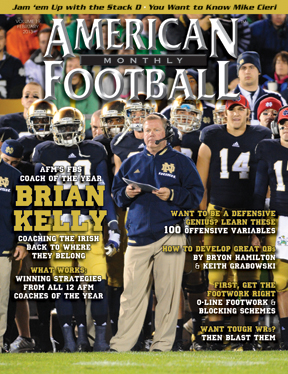Article CategoriesAFM Magazine
|
Zone Blocking, Part II – Footwork and Blocking Schemeby: Ken WilmesherrOffensive Line Coach, Grossmont College © More from this issue Proper footwork and technique are critical for an offensive lineman. In Part I of this three-part series, we introduced our offensive line philosophy, the basics of the zone offense and key offensive line coaching points. In Part II, we will discuss the footwork, co-op blocks, and schemes of the zone game. When executing the footwork for the zone play, linemen will step simultaneously, taking either a six-inch lateral jab step (set to drive directional step) or a bucket step with an angle....The full article can only be seen by subscribers.
|
|
|||||||
| HOME |
MAGAZINE |
SUBSCRIBE | ONLINE COLUMNISTS | COACHING VIDEOS |
Copyright 2025, AmericanFootballMonthly.com
All Rights Reserved





